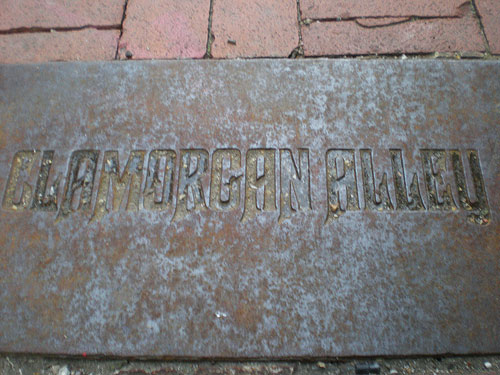The History of Clamorgan Alley
(1784 – 1814)
Who Was Jacques Clamorgan?
Clamorgan Alley (located between present-day 1st Street and 2nd Street) was originally called Commercial Alley and is named after fur trader, merchant, and financier Jacques Phillippe Clamorgan (ca. 1730–1814). A native of the West Indies, Clamorgan’s ancestry was most likely Welsh, French, Portuguese, and African. In 1784, he arrived in Upper Louisiana (St. Louis) while the area was under Spanish rule and worked as a fur trader with the Native American tribes of the Upper Missouri River. He was a prolific land buyer, amassing more than a million acres of western land.
Clamorgan was a lifelong bachelor, but he fathered four children by three mulatto women. The French community at the time accepted and recognized the inheritance rights of his children. As a result, he and his prominent family were wealthy and educated aristocrats at a time in St. Louis when many African Americans were enslaved. In 1858, one of Jacques’s grandsons, Cyprian Clamorgan, wrote a book about the family, The Colored Aristocracy of St. Louis. The book was edited and republished in 1999 by the University of Missouri Press.
The History of Clamorgan Alley
A portion of Jacques Clamorgan’s property included a whole block on Laclede’s Landing at 701–717 N. First Street, which included his home, other houses, barns, and structures. Today, the location falls between the Bi-State Building and Raeder Place.
In 1804, Clamorgan was appointed judge of the court of common pleas, and he rented his house to the government to be used as a jail. Soon after, he co-founded the Missouri Company to promote trade and explore along the Missouri River in an attempt to find an all-water route to the Pacific and to secure his western property. In 1807, in his late seventies, he received a license to trade along what became the Santa Fe Trail and spent months doing just that.
Throughout the 19th-century, Clamorgan’s descendants grew wealthier as the city of St. Louis expanded, running boarding houses, produce stores, and practicing various trades. The family amassed a portion of their wealth from real estate inheritances of property in what is now Laclede’s Landing.
[Sources: Jefferson National Expansion Memorial website, operated by the U.S. National Park Service, nps.gov/jeff/index.htm | John A. Wright: Discovering African American St. Louis: A Guide to Historic Sites, second edition. St. Louis: Missouri Historical Society Press, 2002]
Additional History (from Laclede’s Landing Redevelopment Corporation): Near the time he founded the Missouri Company, Clamorgan sought to prevent losing some of his property by signing it over to his former slave and mistress, Esther. As one of the earliest instances of a female property owner, Esther managed the properties for over ten years. Clamorgan, who had initially intended to grant her the property only as a means to avoid creditors, sought to reclaim the deeds—a long legal process that concluded after the death of Esther in 1833 when the courts restored her property rights per her will.
